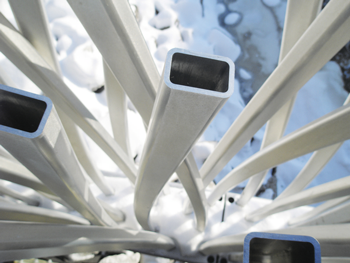A Great Event Dedicated to Extrusion
Organized by the Italian Association for Metallurgy, the Workshop dedicated to the aluminium extrusion system shows the latest trends in terms of plants, machining and finishing technologies, standardization and end uses
by Mario Conserva
Aluminium extrusion in Italy is a compact and flexible industrial system, sensitive to innovation in materials, machines and technologies. After the difficulties shared by all segments of the industry during these years, the sector is following an interesting growth pathway in Italy and in other world markets. This is therefore the most appropriate moment to summarise the development trends required by the global system for solutions, that is, plants, machinery, production technologies and conception of semis at the best state of the art. To provide adequate replies, AIM’s Light Metal and Plastic Machining of Metals study centres organized a new study day on aluminium extrusion, after the successful experience of the first event on this topic held in Brescia in 2016, which focused particularly on the important presence of aluminium profiles in large-volume sectors such as building and constructions, transportation and mechanics. The target of this new initiative by AIM is once more made up of the main players of the production chain and end users, the university world, designers, quality assurance personnel and sales technicians, facing the new challenges which globalisation in recent years has created for operators.
A program focused on new trends
The day’s program, coordinated by Giampaolo Barbarossa and Maurizio Grillo, is centred for the occasion on the added value of semis, a very precise message for the market because aluminium extrusions are enhanced by a high content and a correspondingly high added value. For this class of products, success on the market depends on the validity and originality of the design for the creation of an efficient and competitive item or component. In keeping with this setup, the congress on June 7th is entirely focused on novelties and new trends, the new outlook of the market’s framework, the recent achievements in extrusion techniques, the growing importance of numerical simulation to support the optimal metallurgical conditions during the plastic transformation and the typical occurrences of the extrusion process. An important point concerns the latest metallurgical trends for materials, and for this reason the alloys used will be taken in consideration: the ones with traditional formulae but accurately gauged within the normative parameters, the main variations designed by producers and the new, more advanced compositions, highlighting the continuous progress at metallurgical level, which implies qualitative and quantitative improvements in production and in the optimization of the final properties of the extruded products meant for increasingly sophisticated, high added-value applications.
The theme of the extruded product’s design will be tackled defining the technological constraints necessary to direct the project towards the highest production efficiency, limiting scrap and corrections. Both traditional surface finishings, such as anodising and painting, which have been considerably optimized both from a technical and environmental standpoint, and more recently introduced decorations, capable of exalting aluminium’s extraordinary aesthetic qualities, will be dealt with. The certifications needed for a modern extruder to be competitive on the main markets will also be considered. Machining techniques will refer to different types of applications, even very prestigious ones, such as the creation of space-frames for cars made using highly robotised production lines, applications in the building industry with a broad overview of curtain walls, and significant examples of new applications of extruded products in the lighting sector. To conclude, this will be a comprehensive update for an industry which has got all that it takes to keep on growing, as long as it makes use of all the tools needed to compete on all markets, aiming at innovative applications, replacing other materials, and new design solutions to highlight the specific properties of aluminium and the formability of extruded products

